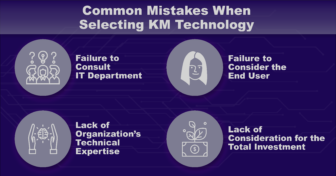Technology is fundamental for any organization seeking to increase its Knowledge Management (KM) maturity or ensure the success of its KM program. When technology is mindfully selected and implemented, it can provide exceptional KM benefits: technology can capture knowledge, store large quantities of information, connect people across the world in real-time, enable positive change, solve complex problems, and automate business processes. The power of technology in promoting Knowledge Management efforts, however, can only be fully realized if an organization selects the right technology for its needs and users.
When the need arises to buy new technology, a great deal of care and consideration must go into the selection process to improve your chances of success. As a technologist who has spent nearly a decade designing, developing, integrating, administering, and selecting enterprise-wide technologies for organizations across the world, I have seen KM leaders fail and learn the hard way to properly select KM technologies. More often than not, the most common technology selection mistakes fall into one of the four categories in the image below:
In this blog, I’ll provide an overview of these four types of pitfalls, and offer advice on how best to avoid them so that you and your organization are empowered and equipped to identify, mitigate, and overcome the common risks that can jeopardize your organization’s next KM technology selection effort. Being aware of these pitfalls will enable you to proactively identify the necessary stakeholders to guide your assessment and make fiscally responsible decisions benefiting both your KM initiative and organization.
Failure to Consult IT Department
T he IT department is one of your most important partners in a KM technology selection effort. IT’s goal is to support the organization’s technology and to maintain the overall health of the technological ecosystem. As such, IT is responsible for knowing the technical details of your organization’s KM ecosystem and should have pre-established processes and criteria to work with technology vendors and support your needs to select, procure, and implement a new technology.
he IT department is one of your most important partners in a KM technology selection effort. IT’s goal is to support the organization’s technology and to maintain the overall health of the technological ecosystem. As such, IT is responsible for knowing the technical details of your organization’s KM ecosystem and should have pre-established processes and criteria to work with technology vendors and support your needs to select, procure, and implement a new technology.
Miscommunication with IT can create a host of issues when it comes to maintaining or enhancing your organization’s KM Maturity. Most notably, failing to effectively communicate with IT when looking to add a new technology to your ecosystem can result in:
- Pushback or lack of ownership from IT once the system is purchased;
- A product that is similar or duplicative to something the organization already owns;
- Delays or problems with implementation caused by lack of knowledge or experience with the technology stack;
- A product that remains siloed from other applications because IT was not aware of what was coming or how it might fit into the larger application ecosystem; or
- A technology that cannot be implemented because it is not compatible with the organization’s security, hosting, or legal requirements.
When selecting a technology without technical input, with only the insight and purview of a non-technical group being taken into account, it is more likely that the selected technology will not work for the organization and contain inconsistent or incompatible features and functionality, resulting in unintentional consequences. For example, a company I worked with recently made the mistake of not communicating with IT when looking to procure a knowledge base to manage internal process documentation. After selecting and implementing a leading market solution, they discovered other units in their organization already leverage similar solutions for the same challenges. As a result of this misalignment, users need to manually copy files from one knowledge base to the next if they want to collaborate between units.
By including IT at the beginning of a selection effort and keeping them involved throughout the process, your organization can ensure that IT’s contextualized knowledge of your technological ecosystem is brought to bear, guiding you to buy something the organization doesn’t already have. One of the most effective ways to keep IT engaged is to communicate early on that this is something they will one day have to support and that you want to ensure it is feasible for both parties. A mature IT department will not only appreciate this gesture, but will quickly involve themselves in the engagement to make certain that they can support whatever tool or system is selected.
Failure to Consider the End User
The end users are your customers and the stakes are high when you’re selecting technology they will have to use and rely on. Concepts like “user adoption,” “user experience,” and “productivity” are most commonly associated with this aspect of the selection process and should remain front-of-mind when determining what your end users may or may not like. 
The first concept, user adoption, is the process where end users become acclimated to a technology and decide to keep using it. It is most commonly used as a post-implementation success metric to track how well the technology is being received and whether the end users find it to be more effective in enabling them to achieve their goals versus what was previously available to them. For this reason, your efforts during the selection process need to focus on selecting a technology that end users will want to use.
A concept that contributes to high user adoption is a technology with a good user experience, something that is considered both during design and development, especially in terms of how easy or pleasing it would be to use. A byproduct of a technology being easy to use is that it is typically easy to explain to others, allowing you to more quickly upskill staff to benefit from the tool or system’s provided capabilities.
Together, the concepts of user adoption and user experience contribute to identifying how well a technology will influence productivity, the rate to which a unit of work can be completed by staff. These ideas go hand-in-hand because technology is the enabling factor in KM, allowing staff to more effectively capture, manage, share, relate, and find knowledge so that they can more efficiently achieve organizational goals, resulting in an increase in productivity.
So how do you ensure that you’re selecting a technology that will be well-received by your end users? The easiest way is to collect their feedback throughout the duration of the selection process and to validate your findings with them on a regular basis. A great starting point is to conduct workshops and focus groups in the beginning of any engagement to develop an initial set of user personas that represent your end users and to capture their preferences in the form of requirements, use cases, and user stories. These artifacts represent the will of the user and are reference points that can be used for the duration of the KM technology selection process. It is recommended to refer back to these artifacts often to make sure that you continue to look for solutions that will benefit your end users. Once you’ve had the opportunity to narrow down your search to a smaller selection of technologies, it’s advised to bring the end users in once more to participate in vendor demonstrations and proof of concepts. This involvement will once again give you insight into what your users are looking for and to validate that you’re taking the selection process in the right direction. Whether you have dedicated resources at your disposal or can only get access to end users once a month, the important part is that you’re involving them in the selection process.
Lack of Organization’s Technical Expertise
 A few months ago I worked with a financial institution that recently purchased a new taxonomy management system with the intention to use the system to automatically apply metadata tags to content stored in multiple repositories so that their staff would not have to complete this process manually. After purchasing the technology, they were surprised to find that none of their technical staff had ever worked with a taxonomy management system before, let alone possessed experience integrating it with an open-source content management system and set up auto-tagging. The organization quickly realized that they had not considered all of the variables necessary to implement the solution and they were lacking the expertise needed to avoid these kinds of mistakes, resulting in further delays.
A few months ago I worked with a financial institution that recently purchased a new taxonomy management system with the intention to use the system to automatically apply metadata tags to content stored in multiple repositories so that their staff would not have to complete this process manually. After purchasing the technology, they were surprised to find that none of their technical staff had ever worked with a taxonomy management system before, let alone possessed experience integrating it with an open-source content management system and set up auto-tagging. The organization quickly realized that they had not considered all of the variables necessary to implement the solution and they were lacking the expertise needed to avoid these kinds of mistakes, resulting in further delays.
Organizations often struggle to find and include experts in technology assessments due to misinterpreting the complexity of their challenge or not understanding the technology they want to purchase. Misinterpreting the complexity of a challenge often means that an organization has not identified all of the symptoms of their problem or its root causes. This lack of understanding can lead to not actually fixing what is wrong and put your entire selection process at risk. Some of the consequences of lacking expert guidance in a technology selection initiative include:
- Failing to properly assess the technology or the vendor;
- Not allocating enough funds to purchase or implement the technology;
- Improperly architecting the future solution and the challenges it will be able to address; and
- Not spending enough time planning the design and implementation of the technology.
The first step you can take to reduce the chances of these mistakes occurring is to have a dedicated resource on the selection team who (1) acts as an subject matter expert (SME) (2) or knows enough about the technology, or has the time and availability to learn about it. You can ask this individual to attend vendor training sessions or to access their demonstration site if one is available. This will give your team valuable insight and hands-on experience to better understand how the technology works.
At EK, we strongly encourage our clients to make sure the appropriate SMEs are involved in the selection process from the very beginning. SMEs are able to hold detailed technical conversations with the vendors, allowing for alignment between the solution’s technical and functional capabilities and the organization’s business needs.
Lack of Consideration for the Total Investment
Understanding the total investment required to own a technology solution is complex and often underestimated. Incorrect estimates of the cost to buy, implement, migrate away from legacy technologies, upskill staff, and support a new technology can derail a technology selection effort. It’s important to take these extra costs into account to avoid incorrect assumptions and budget discrepancies.

Over the past few years I’ve seen an increasing number of organizations not budget correctly for new technology. There is a particular organization I worked with last year who had a small IT department that was looking to migrate their intranet from the Microsoft 365 suite to the Episerver web content management system. They did not correctly budget for costs outside initial licensing fees resulting in funds not being available to quickly implement the solution using outside help. This forced this company to depend on its IT department, one already stretched thin, to get up to speed on the technology and implement it on a tight deadline.
While a technology’s initial sticker price attracts the most attention, I always encourage clients to take into consideration these additional factors and costs before making a decision:
- Implementation – Costs will vary when it comes to adding a new technology to your technology ecosystem. These costs can range from hosting fees and setting up multiple environments to the time it takes your staff to conduct security audits to bring the solution into the environment.
- Migration-Related Costs – Whether you’re replacing an old technology or adding new, there will be costs associated with content and data migration, developing integrations with legacy systems, and setting up existing business processes and workflows.
- Upskilling – Unless your staff have direct experience with the technology, there is most always going to be costs associated with upskilling employees to the point they are able to use the new technology effectively. These costs often include formal and informal training as well as dedicated research time.
- Support – The last factor includes the costs associated with keeping the technology running on a day-to-day basis. This is where you account for the efforts of IT support to assist end users, development efforts to improve or fix the solution, software upgrades, and recurring licensing fees. Organizations will invest the most in this factor post-procurement in year two, and every year afterwards, to appropriately support the technology.
By identifying these costs early on, you will greatly improve the validity of your KM technology selection business case, empowering you to more clearly articulate the support you need from internal stakeholders and to guide conversations with technology vendors. Knowing the total investment needed to own a technology solution is the kind of information that enables you to make fiscally responsible decisions without bankrupting your KM initiative or putting your organization at financial risk.
Closing
Selecting the best technology for your organization can be a difficult task. By building a strong partnership with your organization’s IT department(s), collecting and incorporating feedback from the end users of the technology, embedding technical experts in your technology selection team, and accurately calculating the total costs, benefits, and disadvantages of purchasing a technology, you can avoid the most common pitfalls that cause organization technology selection efforts to be unsuccessful. By avoiding these mistakes, your organization can use technology as it is meant to be used: as an enabler to facilitate your organization’s KM processes and support better KM.
Want to avoid selecting a technology on your own? As a vendor-agnostic Knowledge Management consultancy specialized in both technical strategy and implementation, Enterprise Knowledge can help you select a technology that supports your KM goals, both big and small. You can contact us at info@enterprise-knowledge.com.

